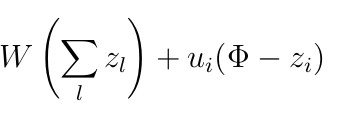Limited-tenure concessions for collective goods

Markets do an excellent job at providing private goods: goods from which you can be excluded. However, there are many goods such as clean air, national armies and dry educational blog posts which behave differently: these public goods become available for a large amount of people once they are created. As a result of their widespread availability, it is not straightforward to determine how much of those public goods should be created. I wrote about the public goods problem and various potential solutions before on the Effective Altruism forum.
In today's paper I'll focus on a single example public good: a population of fish. Without rules in place, such a natural resource is at risk of being overfished by individual parties. More broadly, public goods are likely to be underprovisioned because individuals don't have the incentive to pay for what the larger group may be using.
How are public goods historically provisioned?
The famous Coase theorem states that as long as property rights are well-defined and transaction (bargaining) costs are low, market players should be able to arrive at an economically efficient division of ownership. In that model, governments might need to step in to assign property rights in a fair way, but the rest could sort itself out. However, the problem with public goods is that you can't accurately assign property rights:
"One increasingly common approach is to devolve ownership of these resources to individuals, communities or cooperatives; the idea being that this assignment of property rights creates a sole-owner-like incentive to steward the resource. But even in that setting, because these resources often move in space, one owners’ extraction affects other owners’ future payoffs, and the externality persists. In other words, even perfectly delineated spatial property rights cannot solve the tragedy of the commons for spatially-connected natural resources."
This limitation has not halted organizations from planting their metaphorical flag in particular places, because it is still in individual countries' short term interest to claim their stake. As a result:
"The world’s oceans consist of about 200 property right assignments (exclusive economic zones) traversed by species such as tuna, sharks, and whales (White and Costello 2014). The mismatch between the scales of property rights and of the resource is emphasized as a limitation (Aburto Oropeza et al. 2017) for mobile resources (Costello et al. (2015) or Kapaun and Quaas (2013))."
Alright, so can we do better?
Of course we can! Today's paper discusses a new mechanism through which public good provision can be incentivized: limited-tenure consessions. Or in other words: assigning property rights for a limited duration. By only granting a private organization the right to exploit e.g. a fish population for a limited duration, they may be more incentivized to take good care of it in order to be able to succesfully apply for extensions.
"a concession can be thought of as a limited-duration assignment of a property right to a temporary owner."
Such a mechanism is similar to some of the observations noted by economist Elinor Ostrom in her book Governing the Commons. Ostrom traveled the world to study how both governments and communities cooperated to conserve resources. A common element of many schemes is that individual parties have ownership for only a limited duration - and are acutely aware what their impact is on the stock of fish. In contrast to many of the bottom-up governance systems described in Ostrom's book, today's paper discusses a systematic way for governments to apply this same principle. There are actually many places in the world where this is already implemented:
"TURF systems in Japan, Mexico and Chile contain maximum harvest provisions, whose adherence is required for renewal. As a yearly stock assessment is carried out by consultants approved by
the government to determine a total allowable catch (TAC) for each TURF, such a requirement may translate into a minimum stock requirement (Hilborn et al. (2005)). Wildlife management areas in developing countries rely on ownership devolution to local communities and also require coordination from governments ( Pailler et al. (2015)). Groundwater is increasingly managed by property rights, where an adjudication process relies on a watermaster to enforce the terms of the property
right. Because groundwater migrates spatially according to geological features, the groundwater management setting shares the basic features of our concession system (see Ayres et al. (2018) for real-world cases)"
There are also a number of international member organisations which operate on similar principles:
"The North Atlantic Treaty Organization was one of the first such clubs to receive focused attention by economists (Olson and Zeckhauser 1966). There, 29 member countries each contributes financially and agrees to uphold certain democratic and humanitarian ideals. In exchange for he contributions, members receive public good defense (among other) benefits
that depend on others’ contributions. If a member refuses to contribute the agreed upon share (which, by the way, differs among members), they face likely expulsion from the club (and thus exclusion from the future benefits), though this process can
take time (so T > 1). Most social clubs, such as the historical Confrerie des Chevaliers du Tastevin in Burgundy, France (12,000 members), the exclusive Yellowstone Club in Montana (250 members), and the service-oriented Rotary Club International (1.2 million members) require contributions of time, money, and expertise to sustain membership and enjoy club benefits"
Can you prove this mathematically?
Said no government official ever. But let's go through the exercise anyway! As the saying should go: behind every successful public official there is a thorough researcher. A starting point in our analysis is the realization that there is a small window of opportunity where a private party's incentives may be aligned with society at large. If they are allowed to extract resources for too long, all is lost:
"Thus, for sufficiently long tenure length, concessionaires always defect: tenure must not be too long."
So we should find some way to calculate player's benefits as a function of time. The classic definition of a public goods game can be noted as follows; the main point is to show that a player's utility consists of public component W (which is based on the sum of everyone's contributions), and a private cost zi:

As a result, our player has no incentive to contribute the social optimal level zi∗. Now, how do we solve this?
"Attempting to incentivize efficient provision, consider a new institution under which this game is repeated every period for a limited duration tenure. That is, each period, all N members contribute to, and enjoy the benefits from, public good provision, but any player i’s tenure lasts only for a limited duration. For example, tenure may extend for a period of T = 10 years. A manager has the ability to renew tenure to agent i, and agrees to do so if and only if agent i has acted responsibly, for example if and only if she has chosen zi∗ in every preceding period (up to T)"

If the party defects, they get a one-time higher reward, but as a result they will also miss out on future rewards. One can thereby determine an optimal tenure duration based on the player's costs, benefits and discount factor.
If the discount factor is sufficiently large, so agents are sufficiently patient, then cooperation will always be supported as an equilibrium outcome. [...] sustaining cooperation under a long tenure period requires more patience on the part of the agents.
Can we make the model more complex?
I thought you would never ask! We can make the model more realistic and remove some of the assumptions as follows:
"Natural resources generalize the simple case in important dimensions including natural resource growth (i.e. a production function in which next year’s resource stock depends on this year’s resource stock), mobility (water flows and fish swim), and heterogeneity (e.g. growth or movement can differ over space) in incentives across users"
We model this by taking into acocunt that the fish stock in property i at time t (denoted by xit) is a function of the residual stock in neighboring properties, stock migration patterns and natural stock growth. Moreover, the subsequent profit for a player is a function of the stock of fish they farm and the price pi at a particular property.
There are three different management regimes which today's paper investigates (i) the socially optimal regime, (ii) the decentralized regime and (iii) the concession regime.
(i) The social planner will aim to achieve a certain level of residual stock in order to maximize the net present value of profit across all properties.
(ii) In the second regime each location is owned by a private party who seeks to maximize its own net present value. This leads to destructive selfish behaviour, in line with the simple public goods model:
"At the equilibrium outcome, the owner takes other owners’ behaviors as given and realizes that he will not be the residual claimant of any conservative harvesting behavior. Thus, he behaves as if any additional resource that disperses out of his patch will be lost."
(iii) Limited tenure comes to the rescue again to set the record straight and to incentivize people to behave in a way which is more societally beneficial. As long as private parties maintain a minimum level of residual stock or are below a maximum level of total extraction, their tenure can be renewed. As a result, fish stock is maintained. Note that in contrast to (i), the regulator is only involved in monitoring and handing out property rights. This points to an important design criterion of economic mechanisms. Although many solutions exist to incentivize public goods, we prefer the ones with as little moving parts as possible.
Note that location characteristics such as stock renewal and dispersion rates of course affect a concessionaire’s payoffs and will therefore have an impact on the optimal tenure duration.
There are two more alternative worse models which today's paper discusses: (1) renewal based on maximum total extraction, which may lead to overharvesting in particular time periods, and (2) policies that employ property rights over the resource rather than the location, which may be prohibitively hard to monitor. Good luck tracking where several fish populations move to!
Why do limited duration concessions work?
Conceptually, it is the threat of permanently losing the license which helps to establish a fair valuation. The existence of a cost enforces a real trade-off and subsequent valuation to be made by the private party. This is also similar to other game theoretic findings:
"This tradeoff - of large current period benefits from defection vs. infinite, though lower, benefits from cooperation - is similar to the tradeoff in a Nash Reversion punishment strategy (see, e.g., Mas-Colell et al. (1995)), except that: (1) the punishment happens at date T (not immediately upon defection), (2) the punishment payoff is zero (rather than the Nash equilibrium payoff), and (3) under this setup, other players besides i are not required to play
Nash upon defection."
Today's paper leads to an important final design consideration for concession contracts:
"Contrary to an initial intuition, longer tenure actually induces underprovision. This implies that there is an optimal tenure length, which we derive in the paper."
Perhaps all we need is a frequent reminder of how much we owe to all of our ancestors and everyone around us!
